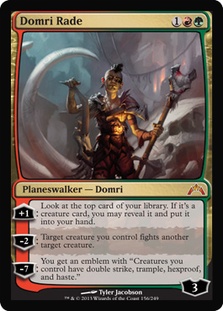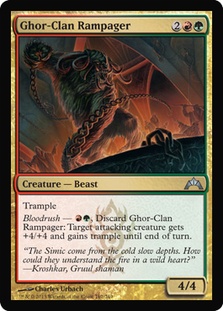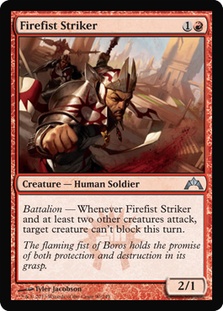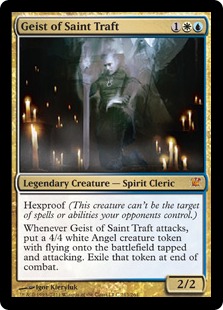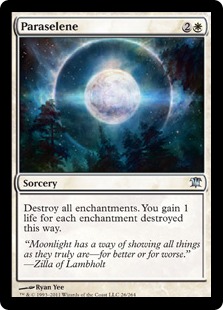Standard has really been getting a workout in recent weeks. Not only has there been a StarCityGames.com Standard Open every weekend, but we’ve seen a Standard Grand Prix, Standard PTQs, and Standard format World Magic Cup Qualifiers, not to mention the constant churn of events on Magic Online. It’s a testament to the development team that the format remains diverse despite this flood of competitive events going on all the time.
Dragon’s Maze has been out for a month now, and we’re seeing tremendous variety in the decks not only showing up at tournaments but finishing highly at them. This past weekend’s Standard Open in Baltimore saw Brad Nelson pilot the previously unheralded Junk Aristocrats deck to victory in a Top 8 featuring six distinct archetypes. The previous week in Dallas, Ken-Min Yeoh bested a similarly diverse Top 8 of six different archetypes with U/W/R Control. Between the two events, ten different decks to made the elimination rounds, with only Junk Reanimator and Naya Aggro showing up in both. If you’re looking at results to get a sense of what decks you need to be prepared for in Standard, these days it can be a little overwhelming!
That’s why this week I’m going to walk through the Standard format as I see it, going over the most important of those decks to prepare for and what makes them tick. Shall we begin?
Naya
I can’t tell you how much it hurts not to have a Standard event to play in during a time when one of the major decks in the format is Naya. Perhaps more than anyone in the world, I’m an honest man who likes attacking with honest creatures. It’s hard to really pinpoint Naya as a single deck in Standard right now, though, since there are quite a few ways you can build the deck. The most popular right now seems to be this version based on Aaron Barich list with which he finished in the Top 8 of the two Standard Opens in Dallas:
Creatures (28)
- 4 Strangleroot Geist
- 4 Dryad Militant
- 4 Loxodon Smiter
- 4 Experiment One
- 4 Ghor-Clan Rampager
- 4 Boros Reckoner
- 4 Voice of Resurgence
Lands (20)
Spells (12)
Sideboard

This is definitely an aggressive take on Naya, with eight one-drops and a curve that barely touches four mana. The goal of this deck is to leverage the efficiency of cards like Experiment One and Dryad Militant along with the resilience offered by Strangleroot Geist and Voice of Resurgence. This build is well suited to beat opposing red-based aggro decks thanks to having a comparable curve with sturdier creatures and preys on what control decks exist with its sheer speed along with the aforementioned Voice of Resurgence.
What seems like it ought to give Naya Aggro trouble—other than its ambitious Boros Reckoner / Strangleroot Geist mana base—is opposing midrange decks, such as the Naya builds played by Willy Edel and Ken Yukihiro at Grand Prix Guadalajara.
Creatures (27)
- 4 Avacyn's Pilgrim
- 3 Restoration Angel
- 4 Thundermaw Hellkite
- 3 Flinthoof Boar
- 3 Loxodon Smiter
- 2 Experiment One
- 4 Boros Reckoner
- 4 Voice of Resurgence
Planeswalkers (4)
Lands (24)
Spells (5)

Creatures (28)
- 4 Avacyn's Pilgrim
- 4 Huntmaster of the Fells
- 4 Restoration Angel
- 4 Thundermaw Hellkite
- 4 Loxodon Smiter
- 4 Boros Reckoner
- 4 Voice of Resurgence
Planeswalkers (4)
Lands (23)
Spells (5)

These Naya decks are much more my speed since they’re decidedly midrange. They trade the blazing speed of eight one-drop attackers for the power of four- and five-drop creatures thanks to Avacyn’s Pilgrim. They also get to play with Domri Rade, perhaps my favorite card printed in the last few years—so I might be a little biased.
If Naya retains the popularity it has right now, I definitely want to be on the side of this version of the deck. Cards like Dryad Militant and Strangleroot Geist are awesome when your opponent isn’t playing many animals of their own, but they look really silly in the face of Loxodon Smiter and Huntmaster of the Fells. It’s a general principle in deckbuilding that in a matchup of similar creature decks, you typically want to be a little bit slower. Your early creatures can keep pace with theirs until you can win with your more powerful cards.
The biggest problem I have with all of these Naya decks is their mana. I really don’t understand how Aaron’s Naya Aggro deck can hope to regularly cast its spells on time with only twelve sources each of red and white mana and only 22 total lands with two basic Forests. If you ever draw a basic Forest, you can pretty much never cast a Boros Reckoner, and you can very easily have hands full of dual lands that can’t cast a Voice of Resurgence or Strangleroot Geist.
Willy’s deck is similarly outrageous to me, with two Gavony Townships in his deck that wants to cast Boros Reckoner as well as overload Mizzium Mortars. It just seems rather ambitious to me. I played a similar deck at Pro Tour Gatecrash, and even with four Arbor Elves for extra mana and fixing, I still felt greedy playing a single copy of Gavony Township. With so many powerful cards in your deck, it seems like you’re better off focusing on having the right colors of mana to actually cast them rather than squeezing a little more value out of your lands.
So if Naya Midrange is the place to be thanks to the popularity of Naya Aggro, what’s the next step? Go a bit bigger, of course.
Junk Reanimator
Creatures (25)
- 3 Acidic Slime
- 3 Arbor Elf
- 2 Fiend Hunter
- 4 Avacyn's Pilgrim
- 4 Restoration Angel
- 3 Thragtusk
- 3 Angel of Serenity
- 1 Deathrite Shaman
- 2 Sin Collector
Lands (20)
Spells (15)

Andres Martinez took down Willy Edel in the finals of Grand Prix Guadalajara with Unburial Rites and friends. While Naya Aggro can look to come out of the gates too quickly for Junk Reanimator to keep up and can fight through blockers like Thragtusk with Ghor-Clan Rampager, the midrange decks have trouble assembling enough damage to really threaten to end the game before Angel of Serenity can come down. Thundermaw Hellkite is sweet, but it’s the only meaningful threat that Naya can muster.
Voice of Resurgence is the new hotness, and playing Junk Reanimator means you get to pretty much laugh in its face. While Voice of Resurgence is an all-star in pretty much every other matchup, it really falls flat when it’s facing off against an opponent who could not care less about a 2/2. It’s still scary when it’s alongside cards like Experiment One and Dryad Militant—which is finally actually proving to be an effective hoser against something relevant: the nut draw of Mulch or Grisly Salvage revealing an Unburial Rites and a fatty—that are actually putting real pressure on you, it’s not going to get the job done when it’s your first play and you’re following up with Huntmaster of the Fells on turn 4.
Junk Reanimator’s biggest problem is dealing with decks that go under it well, meaning decks that are fast enough to win the game before it can set up its insurmountable endgame. Specifically, the decks that are the most trouble are those that are both fast and can bypass its defenses on the ground. Naya Aggro can punch through with Ghor-Clan Rampager, Mono-Red Aggro can ignore blockers with Firefist Striker, and Bant Hexproof can send Geist of Saint Traft in the air—any of which can give Junk Reanimator and its creature-based defenses fits.
If I were to play Junk Reanimator, I’d focus heavily on shoring up these holes given the way the metagame looks these days. Centaur Healer is a card that should probably find its way back into sideboards given how popular aggressive strategies seem to be. We learned long ago that relying on Thragtusk to beat the aggro decks isn’t enough—you need to be able to defend yourself before you get to five mana because at that point you could very easily already be dead.
Speaking of decks that can make you dead quite quickly…
Bant Hexproof
Creatures (21)
- 4 Invisible Stalker
- 4 Avacyn's Pilgrim
- 4 Geist of Saint Traft
- 4 Fencing Ace
- 4 Loxodon Smiter
- 1 Voice of Resurgence
Lands (22)
Spells (17)

I hate this deck. I remember back before Grand Prix Atlantic City when Josh Utter-Leyton posted a preliminary version of his Bant Hexproof deck to our team forum with the message "I’m not going to be playing Magic this weekend." His avoidance of interaction got him to the finals, one of his many impressive performances en route to his Player of the Year title. Perhaps I could do better if I were as willing to stomach the idea of playing a deck like this, but I just can’t handle it.
Bant Hexproof preys on decks that are trying to do anything interesting. Any deck that requires a bit of time to set up and relies on interactive cards to buy them the necessary turns generally just rolls over and dies to a Geist of Saint Traft enchanted with Spectral Flight. Unflinching Courage even gives the deck a way to potentially race other fast aggro decks, matchups that were previously quite poor, though it’s not clear if it’s quite enough to turn those matches all the way around.
If it is, then Bant Hexproof is likely to be one of the best possible choices in the format. Liliana of the Veil, once Standard issue in June in one of the most popular decks in the format, is massively on the decline thanks to how poorly it fares against the trend of ultra-aggressive decks in the format. Few decks in the format now play anything that can deal with Geist of Saint Traft directly. Even the U/W/R decks tend to be more creature focused and play fewer Supreme Verdicts thanks to the latter’s weakness against Voice of Resurgence decks.
If people want to beat Hexproof, the tools are available. Cards like Ray of Revelation, Paraselene, and Glaring Spotlight are in the format. The problem is that those tools are all extremely narrow and Bant Hexproof—for now, at least—makes up only a tiny portion of the field. I think a lot of people have a similar distaste for the deck that I do because it feels like you’re at the mercy of your draws all the time and have no opportunity to leverage your play skill—because, you know, you’re not actually playing Magic.
Has it finally come to this?
There may be an opportunity right now to leverage that distaste. It seems that Bant Hexproof is significantly underrepresented for how powerful the deck is. Playing a relatively underplayed deck that requires very specific sideboard cards to get an edge against is a very good place to be since lots of people won’t be willing to devote slots in their sideboard for the matchup.
While I personally wouldn’t bring Bant Hexproof to a tournament unless I felt I had no other good options, I think it might be a good choice right now. And if I were going to a tournament, I’d keep in mind that like-minded people might come to the same conclusion and be sure not to skimp on the appropriate sideboard cards to beat Bant Hexproof. Even if I don’t make room for specific hosers like Ray of Revelation, I’ll definitely come prepared with anti-Geist cards like Renounce the Guilds, Barter in Blood, or something of the sort.
I’d be remiss if I didn’t talk about the deck that just won the last big event:
Junk Aristocrats
Creatures (24)
- 3 Skirsdag High Priest
- 4 Doomed Traveler
- 2 Young Wolf
- 4 Blood Artist
- 4 Cartel Aristocrat
- 3 Varolz, the Scar-Striped
- 4 Voice of Resurgence
Planeswalkers (3)
Lands (25)
Spells (8)

It’s somewhat strange to me that people are giving Brad Nelson so much credit for this deck when Sam Black suggested it weeks ago, and frankly I’ve never seen a more Sam Black deck in my life. This deck is all about leveraging synergies that arise from sacrificing creatures, and no one likes killing his own creatures more than Sam.
It’s not at all surprising to me that this deck came out on top in a field full of aggressive decks, specifically aggressive Naya decks. All of the cards in this deck match up incredibly well against an opponent who is trying to attack you on the ground with creatures. If you thought Dryad Militant looked bad staring down a Huntmaster of the Fells, try playing it against a deck with Doomed Traveler, Young Wolf, Voice of Resurgence, and Lingering Souls!
Sam mentioned in his original article about this deck that he built it to test the principle that I suggested to him at the Pro Tour regarding Varolz, the Scar-Striped—that playing Varolz in your deck can give you the staying power of midrange deck while preserving the mana curve of a beatdown deck. This deck highlights exactly that, with a curve that tops out at four mana for Sorin, Lord of Innistrad but otherwise barely even touches three and yet has a tremendous amount of power coming from the synergies therein.
The real power card that Brad added to Sam’s original deck is Skirsdag High Priest. In a world of removal-light aggro and midrange decks, Skirsdag High Priest represents an immediate and enormous game-ending threat for only two mana. With a one-drop, a High Priest, and any of the sacrifice outlets, you can start making 5/5 Demons as soon as the third turn, which can be seriously difficult for a lot of decks to deal with. I anticipate future iterations of this deck will stick with the High Priests and would not be surprised to see four of them main become the industry standard. Make sure your deck has a plan to deal with it.
The biggest problem with this deck is its reliance on synergy. The individual cards in this deck, with the exception of Voice of Resurgence and perhaps Lingering Souls, are all very weak on their own. You’re not going to beat anyone with just a bunch of Doomed Travelers, Young Wolves, and Blood Artists. This means that the power of the deck’s draws can vary dramatically. Thankfully, the engine cards of the deck—Cartel Aristocrat and Varolz—are naturally resistant to removal, so you don’t run the same risk many other synergy-based decks suffer from of just having your key creatures killed, but you’re still going to have trouble coming back in a game that comes down to topdecking on an empty board simply because so many of your cards are individually very low impact.
If you’re looking to beat this deck, I think the absolute best sideboard option is Rest in Peace. Not only does Rest in Peace stop Varolz from ever getting his scavenge action on, but it also shuts down every trick the deck does with sacrificing creatures. Despite what the cards say, "dies" actually means "goes to the graveyard from play," and Rest in Peace is a replacement effect that prevents cards from ever reaching the graveyard. This means that death triggers like Doomed Traveler and Voice of Resurgence never happen and morbid never turns on for Tragic Slip or Skirsdag High Priest.
Against a graveyard-based creature deck like Zombies, you run the risk of not getting enough value out of Rest in Peace to be worth it since they can just kill you with their creatures normally, but this deck has virtually no game at all if a Rest in Peace is in play—it’s just a pile of 1/1 and 2/2 creatures that do absolutely nothing. If you can’t beat those, you’ve got bigger problems.
So what does this mean you should play? Well, I don’t know yet. I’m still in the studying phase of my exploration of Standard. Bant Hexproof seems like a good choice if you’re into that sort of thing. Junk Reanimator with a solid anti-aggro plan also seems pretty attractive to me, as does the Junk Aristocrats deck if people don’t catch on to Rest in Peace. I’m looking to brew something up, but I still don’t own any Voice of Resurgences on Magic Online, so I haven’t been able to try out any of the G/W or Naya decks floating around in my head. What else am I really supposed to play?
Until next time,
bmk


